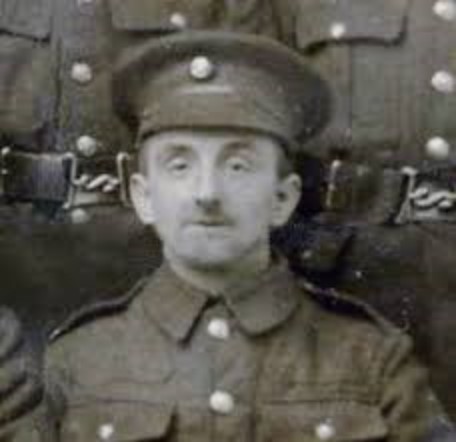
When canvassing the local businesses for information about characters from the time of the First World War for our Ribbon of Remembrance, a major surprise came from Wendy, shop manager at the Castle Hill Bookshop. “You know what my name is?!” was her reply to the enquiry. Wendy Patch is the granddaughter of Harry Patch, the ‘Last Fighting Tommy’.
Henry John Patch died on 25th July 2009, aged 111 years, having attained a level of celebrity that he can never have imagined at the time when he was No 2 on a Lewis gun team in the Duke of Cornwall’s Light Infantry. Harry was an apprentice plumber before he was conscripted into the army at the age of 18. He saw action at the Third Battle of Ypres, though his war came to an end on 22nd September 1917 following a German shell burst which killed three of his fellow Lewis gunners. Harry’s wound saw him hospitalised for 12 months. The Armistice came about while he was convalescing on the Isle of Wight.
Following the war, Harry married Ada Billington, had two sons Denis and Roy and returned to work as a plumber.
Harry only spoke about the war in the latter part of his life and when he did it was without any animosity towards the Germans who faced him across No-man’s Land. As one of the few Great War veterans who survived into the 21st century, Harry was invited to Buckingham Palace and 10 Downing Street. He was awarded an honorary degree by Bristol University in 2004, the Legion d’Honneur by the French government and made a Knight of the Order of Leopold by King Albert II of Belgium.


Explore more memories from the ribbon
-
Captain Robert Murray
Robert Henry Murray lived with his family lived at West Cottage, Richmond. He was educated at Richmond Grammar School, and attended Selwyn College, Cambridge – rowing in the college boat at the Henley Regatta immediately before the outbreak of war. He was commissioned as a Second Lieutenant in the Yorkshire Regiment on 8th October 1914, but was quickly promoted to Captain on the 3rd of December 1914. Attached to the Royal Munster Fusiliers, he was Mentioned in Despatches while at Gallipoli. Captain Murray was killed while attending to a wounded man of his Company on the fire-step of his trench. Captain Murray fell in action on 7th July 1916 and is buried at Philosophe British Cemetery, Mazingarbe, Departement du Pas-de-Calais.
-
Captain Frank Woodcock
Captain Frank Woodcock 5th Battalion of the Yorkshire Regiment Captain Woodcock, who was only 22 years of age, was the youngest son of John and Elizabeth Woodcock of Driffield Yorkshire. He was killed in action during an assault on the 15th of September 1916. Frank was one of 6 children having 2 brothers and 3 sisters, the family must have been “comfortably off” because the 1901 census records his father as “living on his own means” and they had a servant called Margaret. He was educated at Bridlington School, where he was in the Officer Training Corps (O.T.C.). He became a Second Lieutenant in a Territorial Battalion in December 1912. He was promoted Lieutenant in April 1914 and then to Captain in May 1915. The Regimental Gazette recorded his death as follows: “The death of Captain Woodcock deprives his battalion of a very capable Company Commander and a very popular Officer. Despite his youth, he very soon proved himself an Officer of much resource and dauntless courage. He was wounded when wiring in front of the trenches in July 1915, and returned to France in January 1916 when he succeeded to the command of a Company. It was in this capacity that he showed himself a cool and capable Commander with great initiative and pluck, always setting a fine example to his men when any dangerous work had to be performed. He was twice mentioned in despatches. Captain Woodcock is buried at Flatiron Copse cemetery in France.
-
Samuel Staite
This is 65038 Private Samuel Revel Staite, born in 1878, a native of Leeds and self-employed house painter. He joined the army in Leeds on 11th December 1915, at the age of 37. He saw service with the Royal Engineers and the Northumberland Fusiliers. He served with the 6th Battalion, Yorkshire Regiment in North Russia 1918-1919. After the war he returned to his job as a painter. His own son intended to enlist when the Second World War broke out, however, he was employed in a reserved occupation, so Samuel did not have to see him off to war. Samuel died in 1944. Members of the family still live in Leeds. Samuel’s grand daughters Philippa and Deborah brought their treasured family possessions into the museum for us to take care of. Their items relate to his service in Russia in 1918 and 1919, and will help us add to our collections of items from this less well known period of Green Howards history.
